CRM: April abstracts from Ruli24
The Russian CRM market is going crazy. And there are good reasons for that. Users are constantly confronted with the term “CRM system” and sooner or later they begin to look for their solutions, obeying partly the advice of colleagues, partly an urgent need, partly fashion. But at the same time, customers still do not fully understand what they want from the system and why they need it at all. Vendors only add fuel to the fire - in particular, the CRM system is called corporate software of completely heterogeneous configurations: from simple contact managers (notebooks) to programs that are very close to ERP (now they are defined as xRM ). Using the example of our system, we will try to figure out what good CRM systems are, who needs them and how justified it is - to automate transactions, sales and, most importantly, customer relations.

The prerequisites for implementing a CRM system (hereinafter - CRM) strongly depend on the structure of the company and the type of activity. The systems themselves have long moved away from the meaning of the program for customer accounting, transactions and sales automation. Today, the leading CRMs (in any case, those that are found in the reviews on Habré) offer users wide functionality that can be implemented in three main ways.
For the organization as a whole. First of all, this is the creation of a single information space through the accumulation of all information related to the commercial activities of the company. This is the organization and control of business processes, when all steps are interconnected, regulated and strictly consistent. CRM-system as a rearguard of automation of a commercial service allows you to receive data for managing pricing, assortment, competition policy, personnel and marketing.
For the sales department.CRM in this case is alpha and omega, it is working on organizing communication with customers and contractors, information is being accumulated for effective segmentation and future resales, and the work of sales managers is transparent and controlled. At the same time, the presence of CRM protects the company from losing its client base - managers are able to fight this defect due to the flexible distribution of access rights to the system. Using a CRM system, managers collect, structure, and interpret customer relationship information.
CRM is a convenient tool for collecting information that managers and managers need. Each manager in the course of work with clients captures detailed information about each impact and parameters of the client, ranging from details to telephone conversations, which take place including using CRM tools. This forms the most valuable block of information - the customer base.
And finally, for the marketing department . In the conditions of developed online communications, the company wins, ready to make the most personalized offer for both B2B and B2C. Marketing impacts (newsletters, promotions, individual offers) should be based on information: customer segments, consumption profiles, SWOT analysis, ABC analysis. Some CRM (for example, ourRudders24 ) also allow you to collect and process incoming leads.
Once in one of the telecom operators an interview was held on the position of a marketer. As often happens in federal companies, the conversation was long, until the applicant was asked the question: “What is marketing in one word?” The answer turned out to be correct: "Information." Indeed, any marketing decision should be based on information: analysis of the assortment, customer profiles, sales volume, sales stages, external factors. Only in the case of a comprehensive assessment of the data obtained and their detailed analysis can we get balanced marketing decisions that will “shoot”. Everything else is guesswork, no more.
The essence of CRM is simple both from the point of view of the engineer and from the point of view of the user. The client-server architecture of the system involves the creation of records in a database that is stored on a central server (in the case of Rule24 it is its own data center, for a number of other cloud systems it is leased data center capacity). All entries are created by users using the graphical interface (card fields, table fields, etc.). Then, if necessary, operations are performed on the data: editing, editing, deleting, grouping, etc. But that’s how most applications work. CRM, on the other hand, is characterized by the close coherence of the most diverse data.
Let's look at the brick sales chain. The client is contacting the construction company. The manager makes his details, contacts, starts a legal entity / individual. The client is interested in the price. The manager sends the price, sets himself a reminder on the clarifying call in three days. Three days later, the manager calls and clarifies the needs of the client, he answers that he is ready to buy three silicate brick trolleys, but after 2 weeks. The manager logs the event and reserves three trolleys in the warehouse. The storekeeper sees the order and understands that only two trolleys are available. He forms a request to the supplier. Then the client buys the brick. The manager forms a package of closing and shipping documents. The deal goes through. The storekeeper writes off the goods. The manager might not have known that the trolley had been purchased, the storekeeper might not have known where the client was coming from and what channel he had come from. However, in the complex, analysts and managers receive a pool of related information. It forms the basis of analytics and sales development strategies.
Inside the comprehensive Ruly24 CRM system, it is implemented as a module that includes directories, reports, contacts, companies, leads (a company or person is already known, but not yet a client), transactions, calendar, etc. In the Ruley24 system, Processes for Customer Relationship Management include 6 tasks: CRM Administrator, CRM, CRM B2B, CRM B2C. Technical support, Personal account of Ruli24 (functionality is still limited in demo mode).
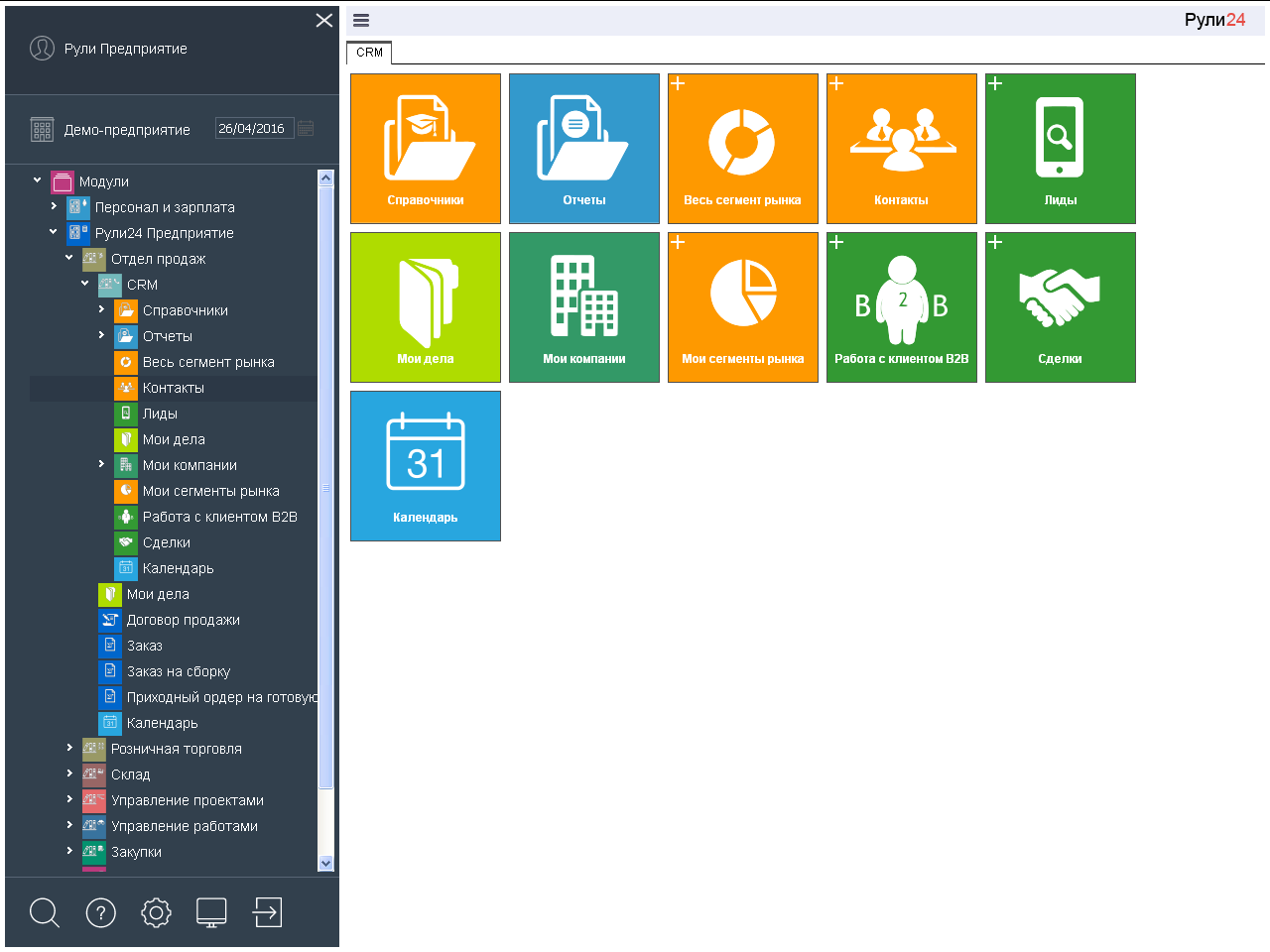
Work with a client begins with a lead - an object, information about which is already there, but the status of a client has not yet been assigned. Leads are not considered in all modern CRM-systems, and in vain - competent management of relations with frets ensures their conversion into clients.
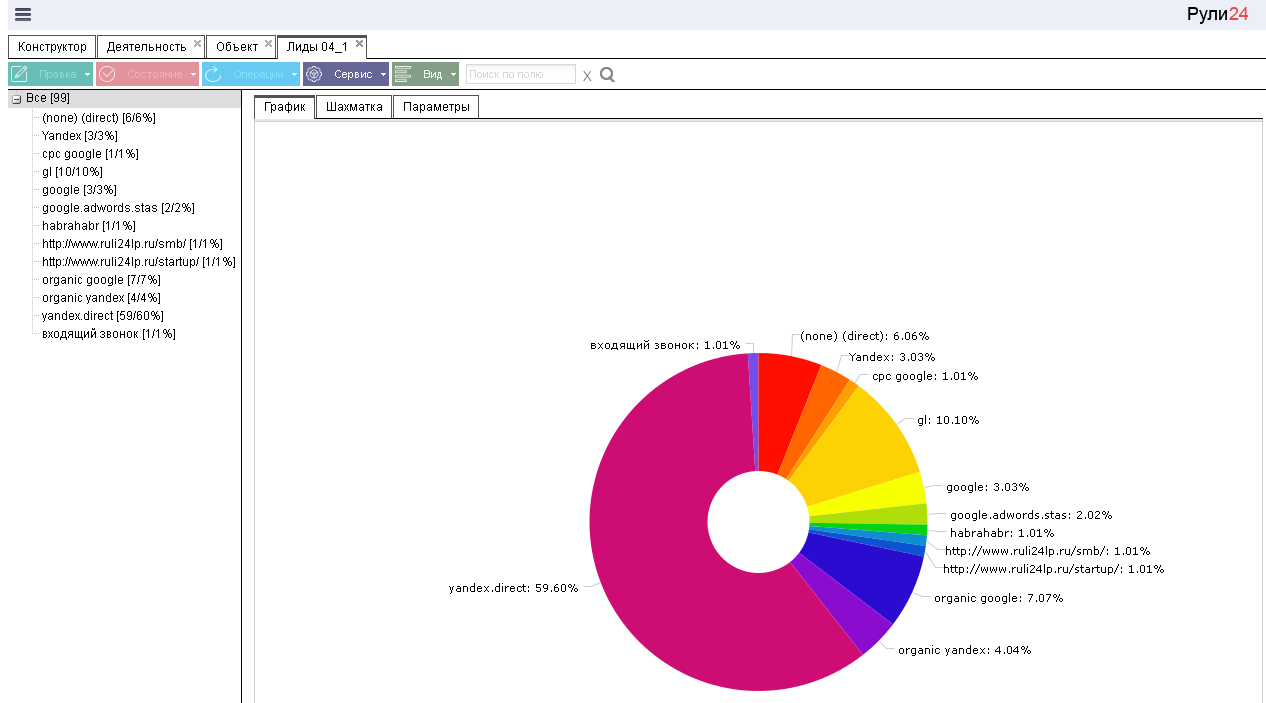
Segmentation of leads by traffic source
Leads can be grouped by traffic source, by separate advertising campaigns. All data can be viewed in tabular and graphical representations.
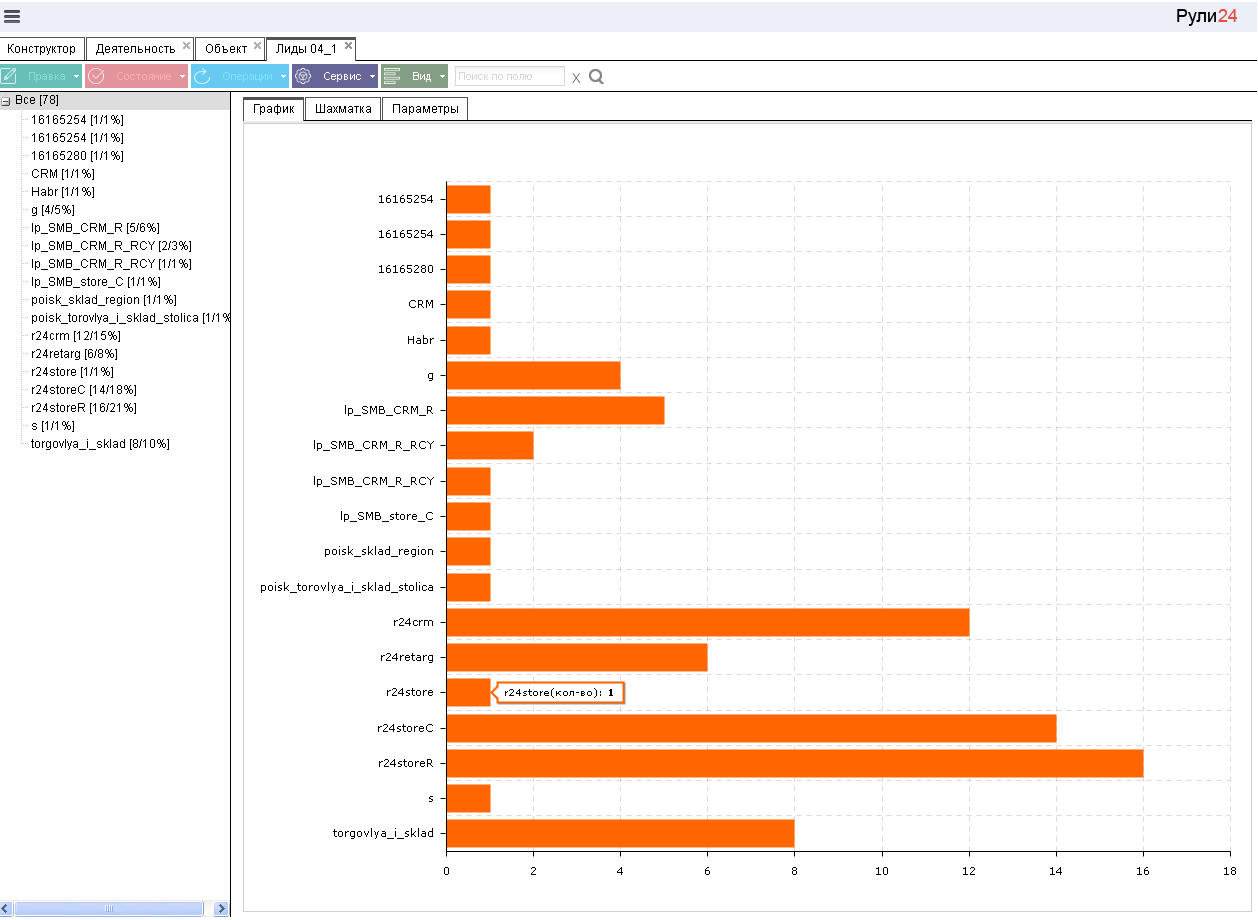
Segmentation of leads by advertising campaigns
In Ruly24, you can analyze leads by products with IP addresses, cities, traffic sources and advertising companies. This allows you to prepare a suitable proposal for them.

Tabular presentation of lead data
For each lead, you can add a note, a file with information, see the transition to the transaction, work with the contact, call statistics with the ability to listen to the record, click statistics on links in the e-mail newsletter, subscription to the newsletter.

The lead management approach implemented in CRM helps to convert them into clients based on analytics, not chance.
Ruli24 differs from other CRM systems by customer segmentation. For medium and large businesses, where the number of customers is large enough, you can keep track of market segments, grouping customers into various groups - such as status or industry affiliation. For example, a company supplies workwear. Then for the purposes of sales and optimal marketing policy should be divided customers into groups. Further analytical work, reports, mailings will be carried out on the basis of such groups.
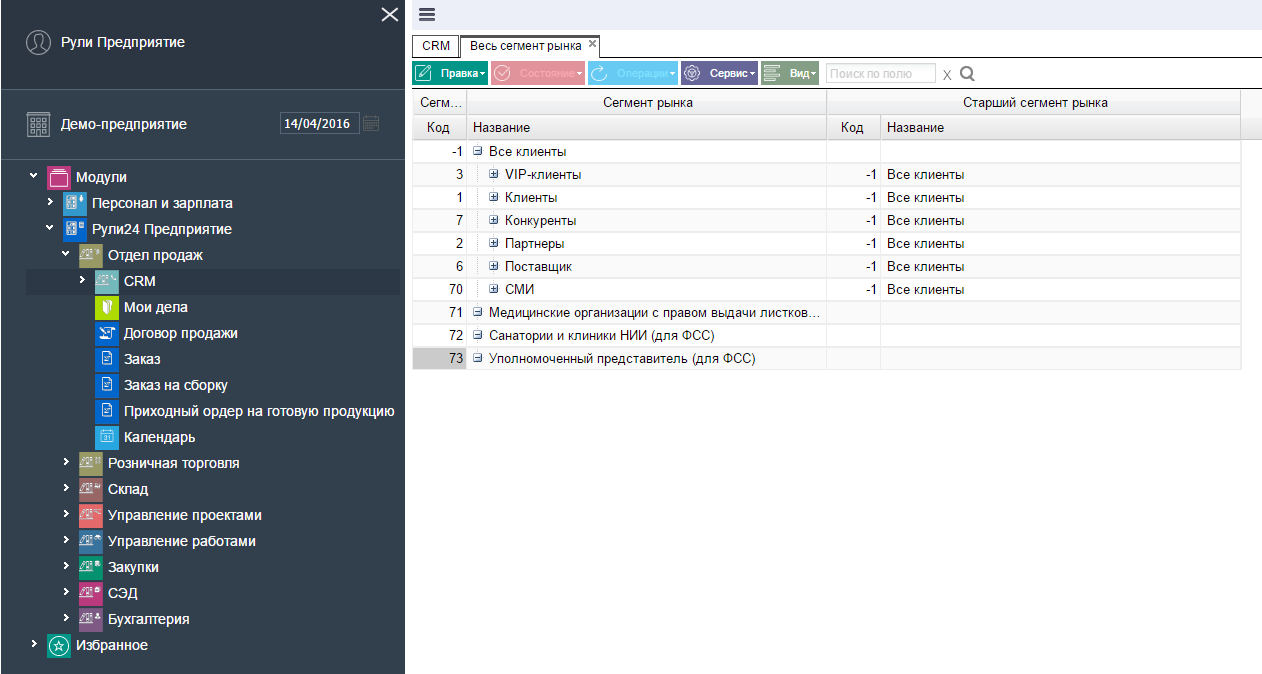
In CRM Rule24 there is a set of ready-made reports in which you can get a set of aggregated data for various parameters. All of these reports together provide much broader information than a standard sales funnel.
Reports are built using the built-in operations: filter, grouping, analytics. For all data, you can generate reports in the form of several types of graphs and reports in the form of a “chessboard”. The reports use the so-called Drill method - refinement.
Reports are primarily necessary for managers to evaluate business performance, operational planning and monitoring, and develop new strategies. Using these simple tools, any user can build reports in several sections, conduct analysis on any data and data elements. The following are examples of transaction reports that you can build in CRM Rule24.
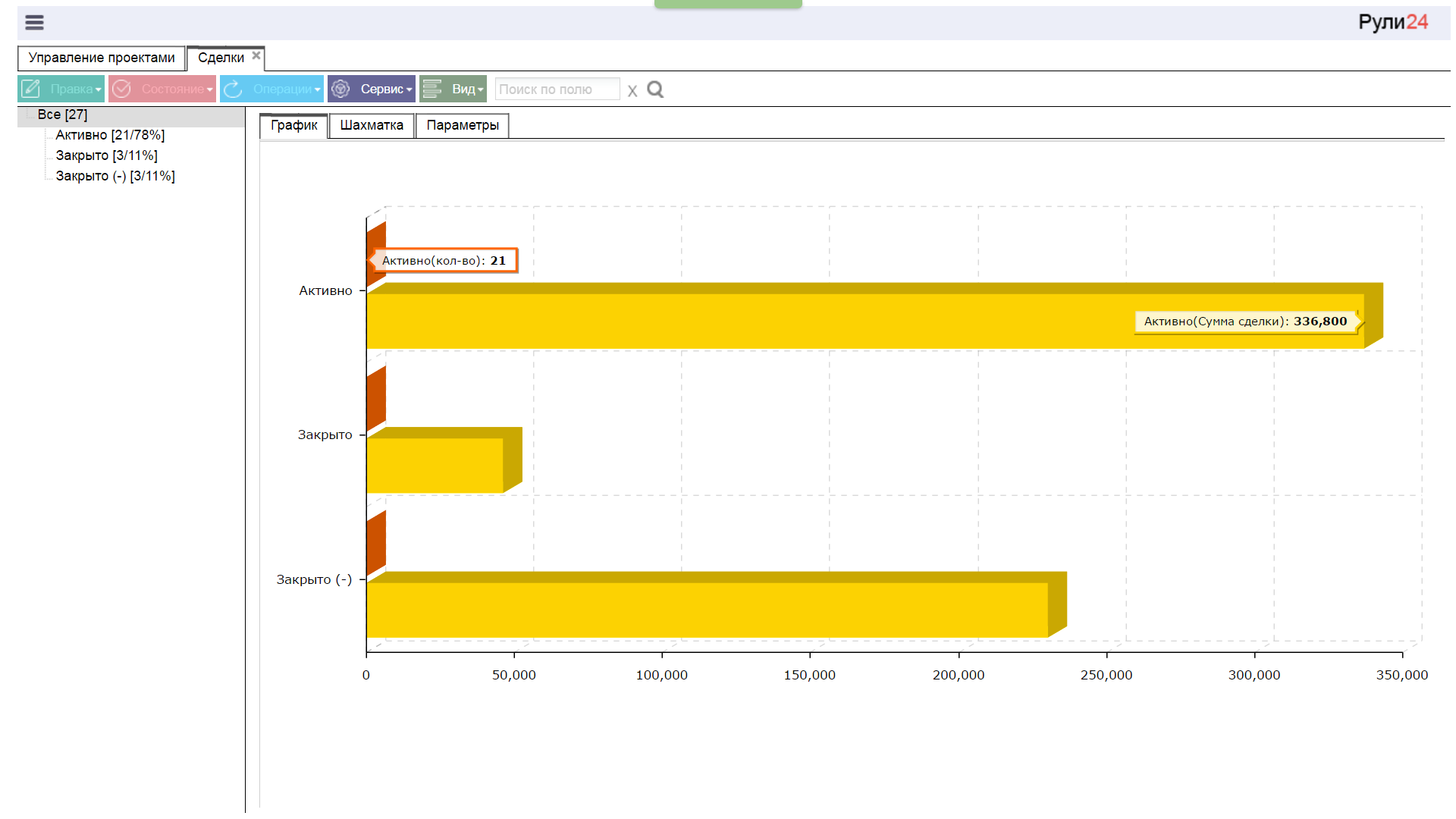
Opportunities for analyzing transactions by state;
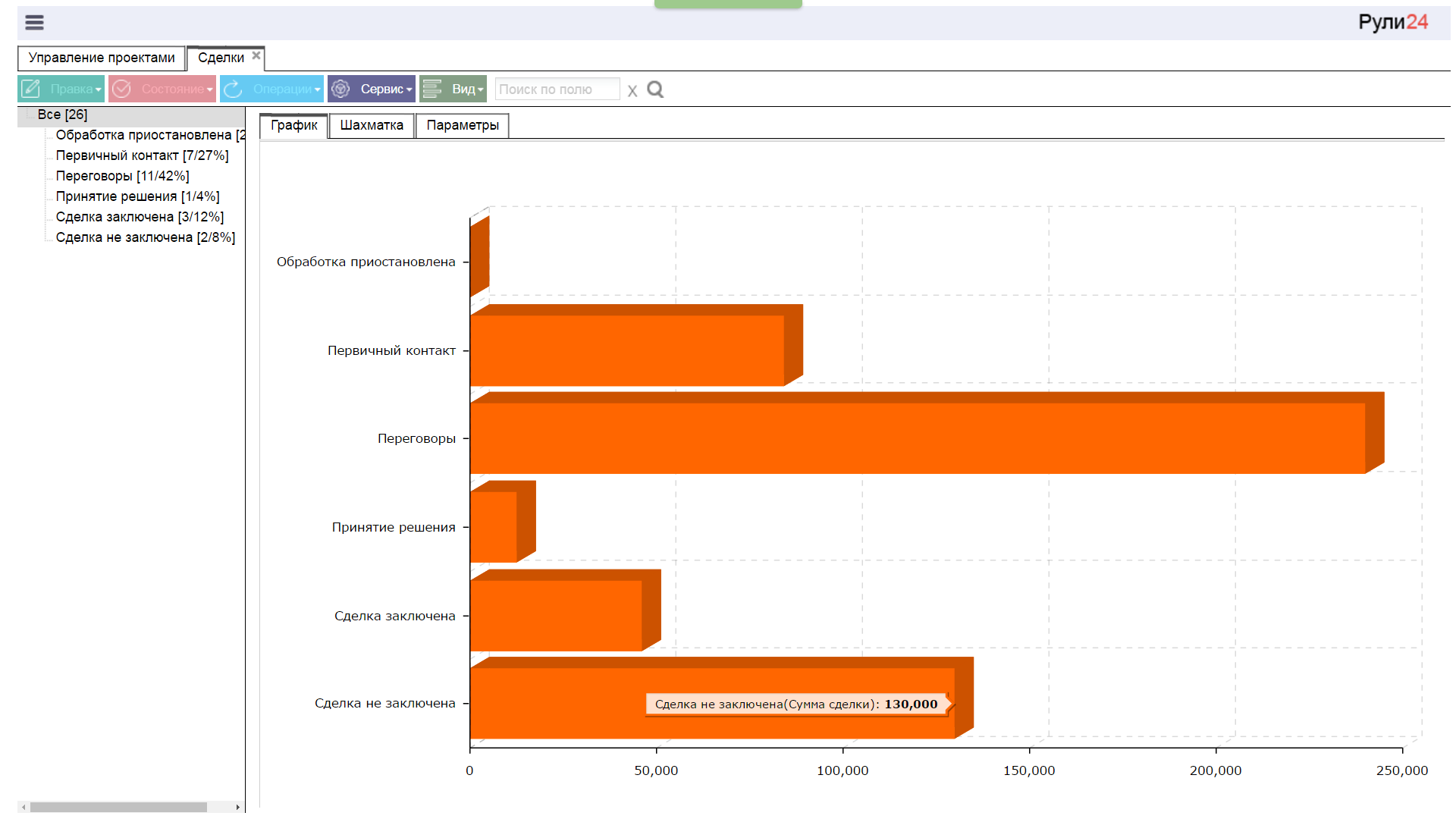
Opportunities for analyzing transactions by stages and amounts;

Opportunities for analyzing transactions by stages and quantity
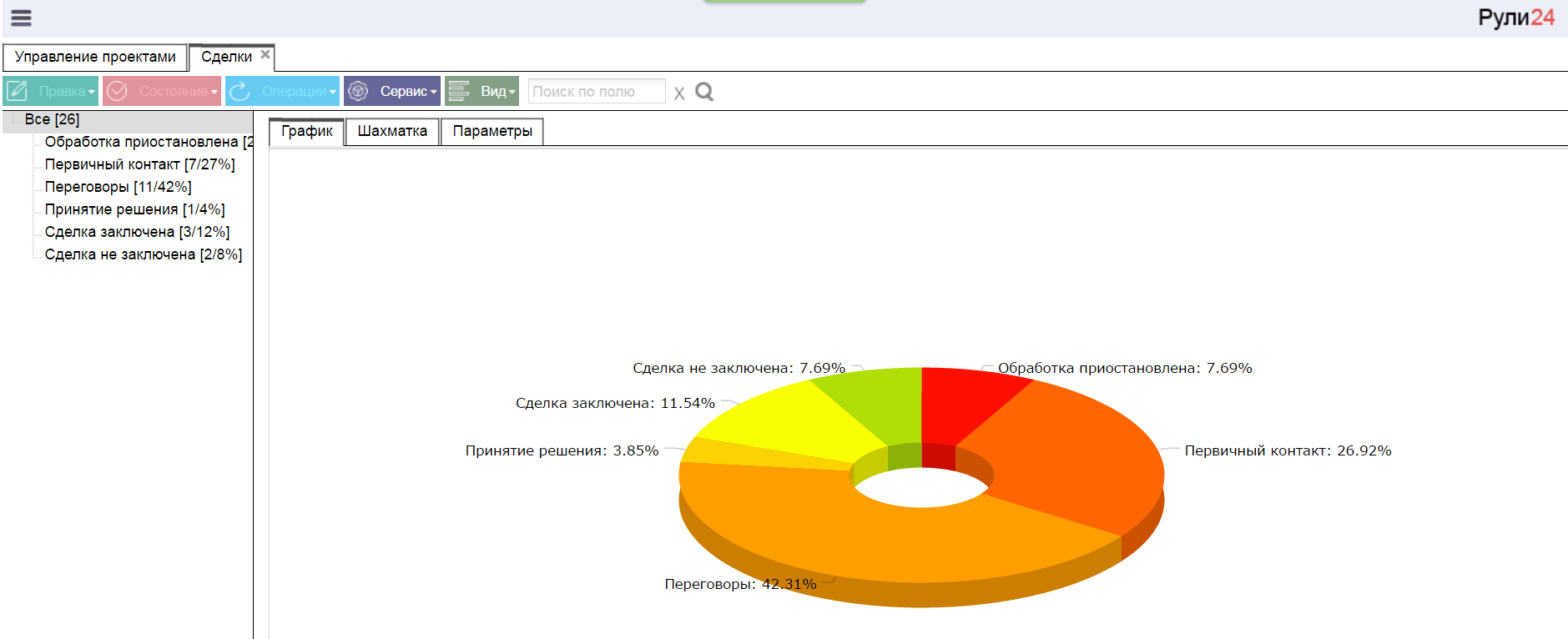
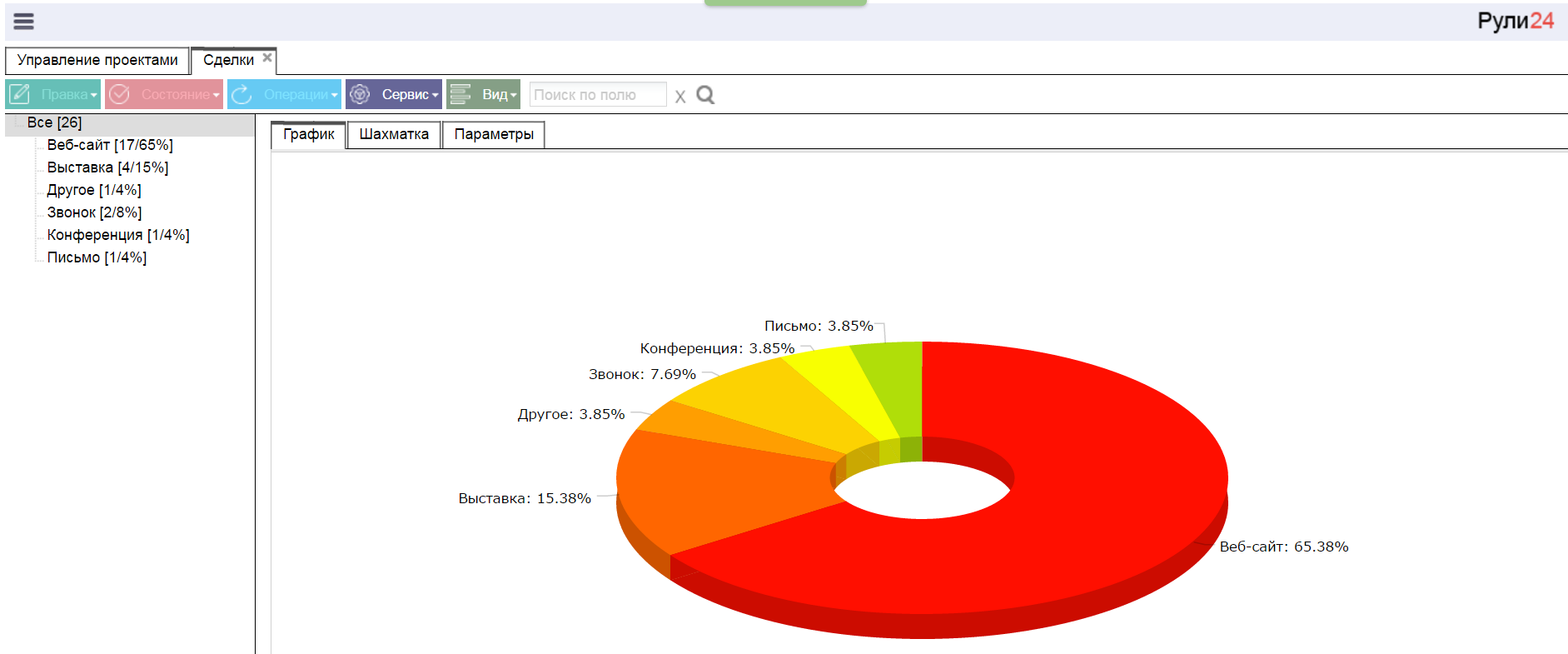
Ability to analyze transactions by source of interest in

the possibility of analysis of transactions as of the performers and the number in the "checkerboard"

Opportunities transactions analysis as of the performers, the number and amount in the "checkerboard"
approach to filling the card in CRM Ruli24 different from other major CRM and aims to optimize the manager’s speed - at the first stage, not all information is entered in the company’s card, but only the most basic data. At the same time, when creating a company, an entry is formed in the contact table. In the future, information on transactions, orders and other blocks will be tied to a contact, company or group of companies.
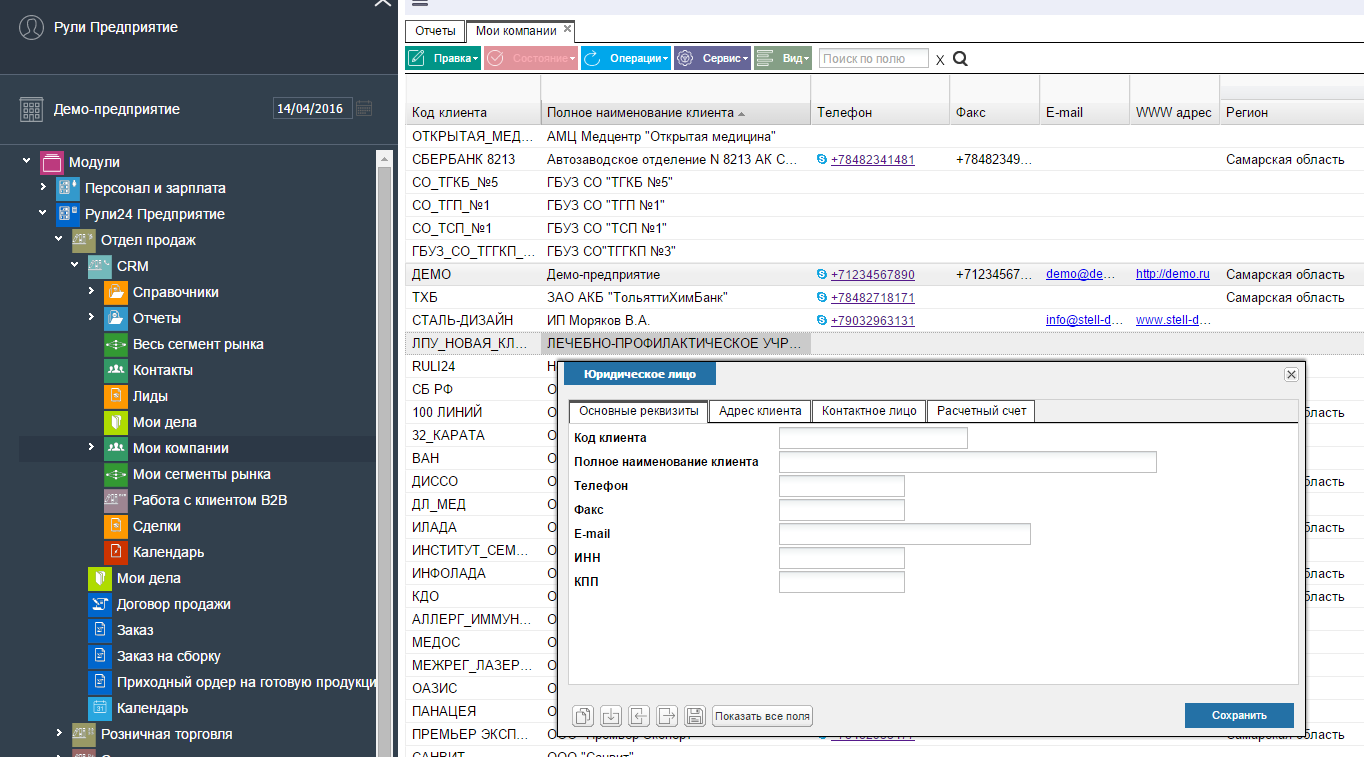
Also at CRM Steering Wheel24Managers and supervisors can create tasks on the calendar, drag them around the field, set reminders. Thus, by opening the calendar, the employee sees all his tasks, crossing them in time. By the way, it is CRM that helps to manage meetings and deals, set goals aimed at constant contact with customers - as you know, you should not forget about those who bought or those who were interested, but refused services. At any time, a favorable offer may appear that stimulates the sale. The manager can see all affairs in one list with the statuses stamped in the “My affairs” tab.

But on these basic things, the functionality of CRM Steering Wheel24 does not end there. Here is a far from complete list of what can be done in the system.
The entire set of actions listed is possible precisely thanks to the well-thought-out system architecture, data connectivity. In many ways, this is why other modules can be integrated with CRM without the slightest compatibility issues.
From year to year, vendors talk about certain areas that without CRM are just nowhere. I think, as of 2016, the answer to the question of the subtitle is simple: “Everyone who has customers needs CRM.” The problem is what it should be and what tasks it should solve. However, it is worth highlighting groups that should definitely pay attention to this type of enterprise software.
Among vendors from time immemorial there is a saying: “If you put CRM in the company where the mess is, you will get an automated mess”. Perfect judgment. However, if you have decided to change the situation in your business and restore order in business, then CRM can become an assistant from the first day - it is almost the same as starting a life from scratch.
Thus, the CRM-system is able to solve important tasks within the company, aimed at optimizing the activities of employees.
Experience shows that companies come to the implementation of systems at different stages of their existence. I can’t say that it is too late — it is difficult. And in almost the overwhelming number of cases (if implementation problems were overcome), the result of using CRM is positive and affects the growth of the company's profitability. So better late than never.

Do you need it?
The prerequisites for implementing a CRM system (hereinafter - CRM) strongly depend on the structure of the company and the type of activity. The systems themselves have long moved away from the meaning of the program for customer accounting, transactions and sales automation. Today, the leading CRMs (in any case, those that are found in the reviews on Habré) offer users wide functionality that can be implemented in three main ways.
- Functional CRM as a separate product is developed, including the entire tool that the vendor has accumulated over the years of development. Such solutions are powerful, optimized and, as a rule, satisfy the needs of several customer segments. But this is also their misfortune - as a rule, functional and price differentiation is manifested rather weakly and a client who wants to get a sales program with a dialer overpays for the entire set.
- CRM with widgets, plugins and connectors. The logic is this: the most basic functionality + for an additional fee (or in development) the necessary features: mail, dashboards, telephony, messenger, integration with the site, etc. This approach is good for those who prefer to choose the functionality on their own, but ultimately bear two risks: price increases due to add-ons and loss of control over third-party applications that may fail at the wrong time.
- CRM as a module of some larger system , when it is part of the integrated automation of the entire enterprise. That is, in fact, CRM, as in the first case, can be connected with other automation tools, but by seamless integration (since all modules belong to one vendor). Moreover, additional modules can be connected and disconnected as the company grows (we recently wrote about the laws of such growth). The benefit is in saving on excessive functionality. By the way, this is exactly how Ruley’s solution is built24 : CRM is a module of a powerful corporate information system (we also call it xRM more and more often). At the same time CRM Rule24 and the organizer can be purchased separately according to the SaaS model - an additional benefit from saving on IT infrastructure (everything is located in our cloud. By the way, we do not use third-party data centers, therefore we are responsible for the level of system availability).
What gives xMM CRM to all departments within the company?
For the organization as a whole. First of all, this is the creation of a single information space through the accumulation of all information related to the commercial activities of the company. This is the organization and control of business processes, when all steps are interconnected, regulated and strictly consistent. CRM-system as a rearguard of automation of a commercial service allows you to receive data for managing pricing, assortment, competition policy, personnel and marketing.
For the sales department.CRM in this case is alpha and omega, it is working on organizing communication with customers and contractors, information is being accumulated for effective segmentation and future resales, and the work of sales managers is transparent and controlled. At the same time, the presence of CRM protects the company from losing its client base - managers are able to fight this defect due to the flexible distribution of access rights to the system. Using a CRM system, managers collect, structure, and interpret customer relationship information.
CRM is a convenient tool for collecting information that managers and managers need. Each manager in the course of work with clients captures detailed information about each impact and parameters of the client, ranging from details to telephone conversations, which take place including using CRM tools. This forms the most valuable block of information - the customer base.
And finally, for the marketing department . In the conditions of developed online communications, the company wins, ready to make the most personalized offer for both B2B and B2C. Marketing impacts (newsletters, promotions, individual offers) should be based on information: customer segments, consumption profiles, SWOT analysis, ABC analysis. Some CRM (for example, ourRudders24 ) also allow you to collect and process incoming leads.
Once in one of the telecom operators an interview was held on the position of a marketer. As often happens in federal companies, the conversation was long, until the applicant was asked the question: “What is marketing in one word?” The answer turned out to be correct: "Information." Indeed, any marketing decision should be based on information: analysis of the assortment, customer profiles, sales volume, sales stages, external factors. Only in the case of a comprehensive assessment of the data obtained and their detailed analysis can we get balanced marketing decisions that will “shoot”. Everything else is guesswork, no more.
What is the essence of CRM?
The essence of CRM is simple both from the point of view of the engineer and from the point of view of the user. The client-server architecture of the system involves the creation of records in a database that is stored on a central server (in the case of Rule24 it is its own data center, for a number of other cloud systems it is leased data center capacity). All entries are created by users using the graphical interface (card fields, table fields, etc.). Then, if necessary, operations are performed on the data: editing, editing, deleting, grouping, etc. But that’s how most applications work. CRM, on the other hand, is characterized by the close coherence of the most diverse data.
Let's look at the brick sales chain. The client is contacting the construction company. The manager makes his details, contacts, starts a legal entity / individual. The client is interested in the price. The manager sends the price, sets himself a reminder on the clarifying call in three days. Three days later, the manager calls and clarifies the needs of the client, he answers that he is ready to buy three silicate brick trolleys, but after 2 weeks. The manager logs the event and reserves three trolleys in the warehouse. The storekeeper sees the order and understands that only two trolleys are available. He forms a request to the supplier. Then the client buys the brick. The manager forms a package of closing and shipping documents. The deal goes through. The storekeeper writes off the goods. The manager might not have known that the trolley had been purchased, the storekeeper might not have known where the client was coming from and what channel he had come from. However, in the complex, analysts and managers receive a pool of related information. It forms the basis of analytics and sales development strategies.
Inside the comprehensive Ruly24 CRM system, it is implemented as a module that includes directories, reports, contacts, companies, leads (a company or person is already known, but not yet a client), transactions, calendar, etc. In the Ruley24 system, Processes for Customer Relationship Management include 6 tasks: CRM Administrator, CRM, CRM B2B, CRM B2C. Technical support, Personal account of Ruli24 (functionality is still limited in demo mode).

Work with a client begins with a lead - an object, information about which is already there, but the status of a client has not yet been assigned. Leads are not considered in all modern CRM-systems, and in vain - competent management of relations with frets ensures their conversion into clients.

Segmentation of leads by traffic source
Leads can be grouped by traffic source, by separate advertising campaigns. All data can be viewed in tabular and graphical representations.

Segmentation of leads by advertising campaigns
In Ruly24, you can analyze leads by products with IP addresses, cities, traffic sources and advertising companies. This allows you to prepare a suitable proposal for them.

Tabular presentation of lead data
For each lead, you can add a note, a file with information, see the transition to the transaction, work with the contact, call statistics with the ability to listen to the record, click statistics on links in the e-mail newsletter, subscription to the newsletter.

The lead management approach implemented in CRM helps to convert them into clients based on analytics, not chance.
Ruli24 differs from other CRM systems by customer segmentation. For medium and large businesses, where the number of customers is large enough, you can keep track of market segments, grouping customers into various groups - such as status or industry affiliation. For example, a company supplies workwear. Then for the purposes of sales and optimal marketing policy should be divided customers into groups. Further analytical work, reports, mailings will be carried out on the basis of such groups.

In CRM Rule24 there is a set of ready-made reports in which you can get a set of aggregated data for various parameters. All of these reports together provide much broader information than a standard sales funnel.
Reports are built using the built-in operations: filter, grouping, analytics. For all data, you can generate reports in the form of several types of graphs and reports in the form of a “chessboard”. The reports use the so-called Drill method - refinement.
Reports are primarily necessary for managers to evaluate business performance, operational planning and monitoring, and develop new strategies. Using these simple tools, any user can build reports in several sections, conduct analysis on any data and data elements. The following are examples of transaction reports that you can build in CRM Rule24.

Opportunities for analyzing transactions by state;

Opportunities for analyzing transactions by stages and amounts;

Opportunities for analyzing transactions by stages and quantity


Ability to analyze transactions by source of interest in

the possibility of analysis of transactions as of the performers and the number in the "checkerboard"

Opportunities transactions analysis as of the performers, the number and amount in the "checkerboard"
approach to filling the card in CRM Ruli24 different from other major CRM and aims to optimize the manager’s speed - at the first stage, not all information is entered in the company’s card, but only the most basic data. At the same time, when creating a company, an entry is formed in the contact table. In the future, information on transactions, orders and other blocks will be tied to a contact, company or group of companies.

Also at CRM Steering Wheel24Managers and supervisors can create tasks on the calendar, drag them around the field, set reminders. Thus, by opening the calendar, the employee sees all his tasks, crossing them in time. By the way, it is CRM that helps to manage meetings and deals, set goals aimed at constant contact with customers - as you know, you should not forget about those who bought or those who were interested, but refused services. At any time, a favorable offer may appear that stimulates the sale. The manager can see all affairs in one list with the statuses stamped in the “My affairs” tab.

But on these basic things, the functionality of CRM Steering Wheel24 does not end there. Here is a far from complete list of what can be done in the system.
- You can make customers as users with limited rights and create a personal account for each of them. In this case, customers can use the CRM-system as a way to receive technical support, see the status of their account, contract, bills, acts, payments, the history of changes in tariff plans. They can receive an invoice and pay it both through a p / account and through cards and electronic wallets such as Yandex.Money, Webmoney, etc.
- You can start and group leads so that you can transfer them to client status or delete them.
- You can create your reports in any section of the data. In terms of speed of reporting and the ability to upload data of any structure and any level of complexity, CRM Rule24 can argue with eminent competitors. Such capabilities are realized through the use of a powerful Oracle database. By the way, our clients do not pay for the purchase of a DBMS, since it is deployed on our side, and the client receives CRM as a service from the cloud (SaaS). For small and medium-sized businesses this is a weighty argument. In addition, Oracle is not very easy to maintain and administer - and the Ruley24 team takes care of that.
- CRM gives the head of the department and company a reliable control tool - the administrator can create and view current work plans for each of the managers, monitor and analyze all the work performed by those responsible with groups of assigned clients. You can not listen to promises, but simply control the progress of the plan and make adjustments within the reporting period, while you can still fix something.
- As for the primary and other documentation, this is often a problem point in foreign CRMs (they are tailored to other principles, for example, invoicing, and require refinement) and in Russian systems (there is only a part of forms, outdated templates). In Ruly24 there is the possibility of processing any necessary documents for work. It can be an invoice, a commercial offer, a contract, an act, an invoice or any other document you need.
- CRM provides many tools for sales statistics, analysis and graphical representations of data, telephony and much more.
- You can create download widgets for each manager and get a transparent picture of the sales department, redistribute tasks, and adjust further actions.
The entire set of actions listed is possible precisely thanks to the well-thought-out system architecture, data connectivity. In many ways, this is why other modules can be integrated with CRM without the slightest compatibility issues.
Who needs CRM?
From year to year, vendors talk about certain areas that without CRM are just nowhere. I think, as of 2016, the answer to the question of the subtitle is simple: “Everyone who has customers needs CRM.” The problem is what it should be and what tasks it should solve. However, it is worth highlighting groups that should definitely pay attention to this type of enterprise software.
- Institutions with a large flow of customers - individuals: medical centers, banks, sports clubs, cosmetics stores, manufacturers of services and exclusive goods (optics, orthopedics, event). For such companies, CRM is, first of all, a tool for ensuring a loyalty program: linking accumulations and bonus programs, discount cards, purchase history. Companies of this kind are required to have a flexible assortment, to identify and withdraw unclaimed positions on time. Without CRM, this is problematic. Yes, and ringing customers and doing mailings from CRM is not an example easier than from an Excel file or a recording log.
- Institutions with a large flow of customers - legal entities. If you work in B2B, you must share the values of time and commitment. Accordingly, software helps to meet deadlines and keep a history of relationships.
- Companies whose sales have a long cycle - building long-term relationships, leading a customer is most convenient in CRM: you don’t forget anything and get excellent analytics on the sales funnel, you can identify at which stage of the cycle the most failures occur.
- Companies with a complex organization of business processes. In them, CRM must be integrated with other automation elements in order to turn routine processes into a real conveyor.
- Retail and retail stores that need extensive inventory and loyalty programs.
Among vendors from time immemorial there is a saying: “If you put CRM in the company where the mess is, you will get an automated mess”. Perfect judgment. However, if you have decided to change the situation in your business and restore order in business, then CRM can become an assistant from the first day - it is almost the same as starting a life from scratch.
Thus, the CRM-system is able to solve important tasks within the company, aimed at optimizing the activities of employees.
- An integrated approach to company management, accounting and information collection due to the connectivity of the system modules.
- Aggregation and interpretation of information for making management and marketing decisions, as well as for managing customer relationships.
- Operational work of managers with calls and e-mail, processing customer requests due to the capabilities of telephony and service management.
- Data preservation - corrupting data in CRM is much more difficult than in Excel spreadsheets. This is due to the use of a single database, the availability of a backup system for the database and the distribution of access rights to the system.
- Operational exchange of information between employees and departments: rotation of customers, delegation of tasks, coordination of orders and contracts.
- Customer personification - referring to a customer based on the parameters of the card and the profile of interactions.
Experience shows that companies come to the implementation of systems at different stages of their existence. I can’t say that it is too late — it is difficult. And in almost the overwhelming number of cases (if implementation problems were overcome), the result of using CRM is positive and affects the growth of the company's profitability. So better late than never.
